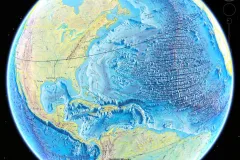Making a Mark on the Ocean Floor

Until very recently oceanography was a field dominated by men. A seafaring career, oceanography was still influenced by the superstitions of ship life; a woman on board was considered to bring bad luck. It may come as a surprise then, that one of the most influential oceanographic cartographers (mapmakers) of the 20th century was a woman, and she achieved such status without even stepping foot on a boat.
Marie Tharp is credited with producing one of the world’s first comprehensive maps of the ocean floor. She and research partner Bruce Heezen transformed a once barren and flat landscape into a dynamic three-dimensional space with mountains, valleys and trenches. The maps she produced in the 1950s would spark a debate and later the discovery of the Mid-Atlantic Ridge, one of the key clues supporting the theory of continental drift. Today, Google Ocean features Tharp’s hand-drawn work in the Marie Tharp Historical Map, which reveals the once hidden ocean floor to a generation of web users.
Oceanic cartographer was not a conventional career for a woman in the 1950s. However, as a child Tharp was exposed to mapping and conducted field work with her father, a surveyor for the United States Department of Agriculture, often helping him collect soil and rocks.
“I guess I had map-making in my blood, though I hadn’t planned to follow in my father’s footsteps,” she wrote in her book, Connect the Dots: Mapping the Seafloor and Discovering the Mid-ocean Ridge.
Her passion for knowledge led her to Ohio University where she earned a degree in English and music in 1943. By the time of her graduation, the United States was in the middle of World War II, and the nation was in desperate need of educated workers to fill the void left by men heading to battle. An opportunity opened at the University of Michigan for female students in the geology department, and Tharp became one of the master’s programs first “Geology Petroleum Girls.” Finding work within the petroleum industry unfulfilling, she earned a third degree in 1948 from Tulsa University in mathematics. Upon graduation she landed a position at the Lamont Geological Laboratory of Columbia University where she would conduct her most influential work.
From the halls of Columbia and sometimes her desk at home, Tharp became an interpreter and artist, analyzing SONAR pings from vessels crisscrossing the ocean and then scribing the data on canvas by hand. As she meticulously crunched and plotted data sent from ships in the open sea, an unknown world unfolded before her eyes. Continental shelves dipped to deep abyssal plains that were interspersed with canyons, mountain ranges and seamounts. One feature, a deep, continuous trench splitting a mountain range along the entire Atlantic Ocean, seemed too important to dismiss. After extensive thought and recalculation Tharp proposed to Heezen, her superior, that they were looking at a rift valley—an area where the earth’s crust splits and magma rises to form new crust. But the idea of continental drift was so controversial within the scientific community that Heezen dismissed Tharp’s hypothesis as “girl talk”—and then made her re-do all the charts.

Marie Tharp and Bruce Heezen with their map of the ocean floor. Photo Credit: Flickr user marie tharp maps https://www.flickr.com/photos/marietharpmaps/537480113/
It wasn’t until Heezen himself discovered clustered seismic activity along Tharp’s ridge that he began to agree with her rift valley hypothesis. After public announcement of the Columbia lab’s discovery in 1957, a doubtful Jacques Cousteau, the famous ocean explorer, set out to disprove the unimaginable idea using one of his deep sea submersibles. Upon his arrival at the bottom of the ocean, Cousteau was dumbfounded–Tharp’s rift valley was exactly where she mapped it to be.
With Tharp’s ocean floor maps in hand, scientists during the 1960s formulated a revolutionary theory, what is now the accepted idea of plate tectonics. It wasn’t until recently, however, that Tharp earned due credit for her work. In 1997, twenty years after the publication of her ocean map by the U.S. Office of Naval Research, she received honors from the Library of Congress, with her maps displayed in the 100th-anniversary Geography and Map Division celebration beside journal entries by Lewis and Clark.
Despite the public doubt, hardship, and obstacles that characterized much of her career, Tharp remained dedicated to her work, believing her maps would do the talking for her. “I was so busy making maps I let them argue. I figured I’d show them a picture of where the rift valley was and where it pulled apart,” she once wrote. “There’s truth to the old cliché that a picture is worth a thousand words and that seeing is believing.”

